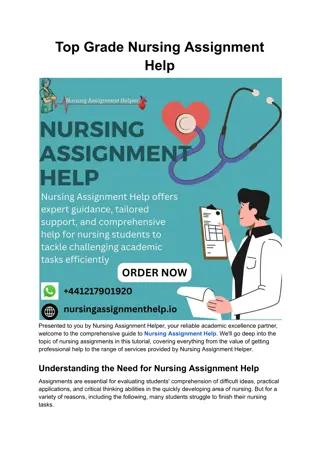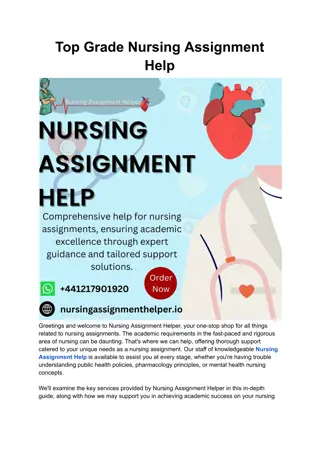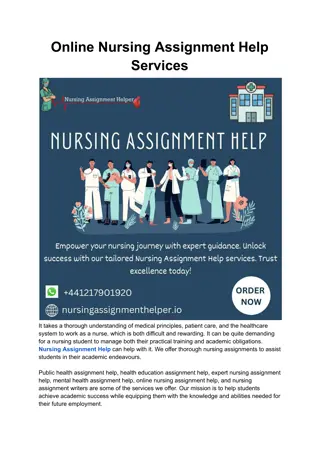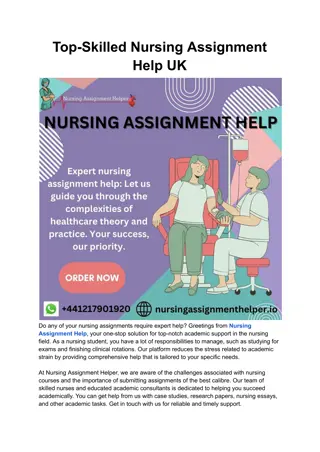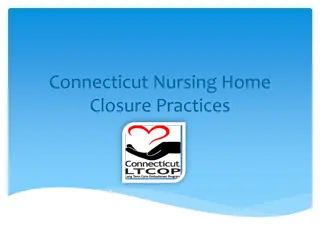Translating Qualitative Findings Through Videography in Nursing
In this study, qualitative findings are translated through videography to explore the experiences of individuals living in an independent apartment within an emergency shelter. The research addresses the challenges and potential solutions in providing affordable housing and support services. The study aims to uncover the nuances and diverse perspectives of shelter residents, guiding program changes that are responsive to their voices. Mixed methods approach blends interpretive phenomenology with quantitative data analysis to capture shifts in well-being among new tenants.
Download Presentation

Please find below an Image/Link to download the presentation.
The content on the website is provided AS IS for your information and personal use only. It may not be sold, licensed, or shared on other websites without obtaining consent from the author.If you encounter any issues during the download, it is possible that the publisher has removed the file from their server.
You are allowed to download the files provided on this website for personal or commercial use, subject to the condition that they are used lawfully. All files are the property of their respective owners.
The content on the website is provided AS IS for your information and personal use only. It may not be sold, licensed, or shared on other websites without obtaining consent from the author.
E N D
Presentation Transcript
Translating Qualitative Findings Through Videography EQRC 2020, Las Vegas School of Nursing
Team Abe Oudshoorn, Assistant Professor, Western University Carrie Marshall, Assistant Professor, Western University Deanna Befus, Assistant Professor, Western University Colleen Parsons, Research Assistant, Western University
Funding This Project entitled Transforming Emergency Shelter into Affordable Housing with Support received funding from the National Housing Strategy under the NHS Demonstrations Initiative, however, the views expressed are the personal views of the author and CMHC accept no responsibility for them. Ce projet Transforming Emergency Shelter into Affordable Housing with Support a re u du financement dans le cadre de l Initiative de d monstrations de la Strat gie nationale sur le logement. Cependant, les opinions exprim es sont les opinions personnelles de l auteur et la SCHL n accepte aucune responsabilit l gard de telles opinions.
Background If Housing First works, we have extra space (capital assets) Current needs in the sector: Permanent housing Housing with supports Addiction supportive housing History of the Salvation Army Centre of Hope New youth shelter
Significance and Research Problem Shelter providers don t necessarily have policies in place to become landlords Shelter policies may be incongruent with supportive housing People may not want to live in a shelter building Affordable housing across Canada is desperately needed
Research Question Unknowns: What is it like to live in an independent apartment within an emergency shelter? Would anyone even want to live here?
Paradigm Interpretive Value of the subjective experience Program changes should be responsive to voices of those they serve Experiences are nuanced and diverse
Methodology Mixed methods QUAL-quan Primary approach is interpretive phenomenology Supplemented by quantitative data to captures shifts in well-being of new tenants
Methods Data Collection: All interviews were conducted by a Research Assistant using a semi-structured interview guide. 16 interviews were audio-recorded. Participants were invited to do a follow-up interview on video if they were interested and comfortable with this. 9 residents participated. Videographer was recommended by the Centre for Research on Health Equity and Social Inclusion (CRHESI)
Data Analysis Qualitative: Braun and Clarke s (2006) thematic analysis. For data familiarization, the research assistant who conducted the interviews did preliminary coding and proposed draft themes. Draft themes were presented to the co-investigators for feedback. From there, final revisions to themes were made and written by the research team.
Results Participants overwhelmingly approved of living in private rooms in an emergency shelter building Independence but with support available Meal programs A big step up from shelter dorms
In Their Words The cleanliness is a whole new thing. So paying the $500 a month is worth it just waking up not having to step on a needle, or urine, or vomit. So that s worth the money. It s private. You get, you have your own bed. So you don t have to worry. You can clean it, you know, as well as you want to live in it. So you have your own toilet, your own private shower, again, your own bed. So the privacy is great.
Now that we know the results, How Do We Tell a Powerful Story?
In Video https://www.abeoudshoorn.com/transformin g-emergency-shelter-demonstration-initiative/
What we Learned, Positives: 1. Video is high impact KT compared to quotes 2. Participants engaged in their videos in a deeper way than we ve seen with other member checking 3. If findings are positive, this has unintended benefits to the agency and the funder 4. Very different than video interviews, even different than video elicitation
What we Learned, Negatives: 1. Very costly and time consuming to do well (multiple edits?) a) Decreased editorial control 2. Not conducive to sharing details of methodology/methods/sample 3. Complex ethics and consent process



